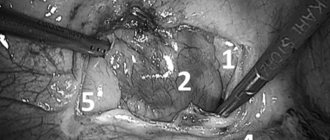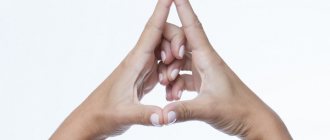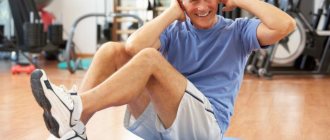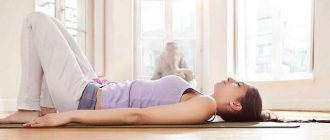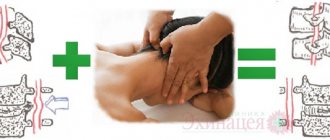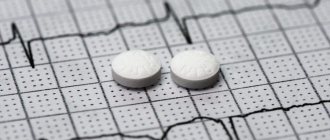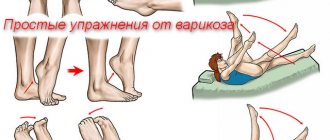13 minutes
“Currently, about 30% of people (28% men and 34% women) aged 15 years and over in the world were not physically active enough. Approximately 3.2 million annual deaths are associated with insufficient physical activity" (World Health Organization)
Myocardial infarction is necrosis (death) of the heart muscle (myocardium), which occurs due to acute insufficiency of coronary blood flow.
Read more about myocardial infarction, risk factors for its development and rehabilitation here: “Rehabilitation after myocardial infarction”
Physiotherapy exercises for myocardial infarction begin on the 2nd or 3rd day. First, exercises that are feasible for the patient are carried out, ensuring mobility in small and medium-sized joints, then the exercises become more complicated.
Wider use of physiotherapeutic rehabilitation begins from the 30-45th day from the onset of acute myocardial infarction in rehabilitation departments, sanatoriums or clinics. During this period, a set of measures is used, including strictly dosed walking, therapeutic exercises, and physiotherapeutic procedures.
Recommendations for physical activity, types of exercises and their duration are developed by the doctor, based on the age, weight of the patient who has suffered a myocardial infarction, the severity of damage to the heart muscle according to clinical, biochemical and electrocardiographic indicators, and the presence of concomitant diseases.
The Cardiological Sanatorium operates a medical program “Recovery”, within the framework of which the rehabilitation of patients who have suffered a myocardial infarction is carried out.
Is it possible to play sports?
The heart muscle, like other muscles in the human body, needs training. Arrhythmia, related to diseases of the cardiovascular system, can be treated with physical activity with the right approach and reasonable exercise. For example, light running, just walking, and various types of exercise therapy are very popular. Wherein:
- stimulates glucose absorption;
- the body receives more oxygen;
- additional energy is released;
- the heart begins to work in an economical mode;
- Strength increases and heart rate decreases.
To fulfill all these conditions, regular classes are required, in between which a doctor assesses the patient’s health. The physical form of each patient is determined through special diagnostic procedures.
conclusions
Adequate physical activity is indicated for almost all patients with rhythm disturbances during the absence of an attack. The main thing is to select it together with a cardiologist during functional stress tests. The required level of energy expenditure is calculated using the formula depending on the maximum heart rate: the person’s age must be subtracted from two hundred and twenty. 75% of this value is a frequency that cannot be exceeded during training. A competent approach to physical education significantly improves the patient’s quality of life.
Exercise for heart rhythm disturbances
For patients with arrhythmia, it is best to start their morning with exercise. Its daily repetition helps normalize the heartbeat and increases the strength of the heart vessels. A standard home complex is:
- walking in place;
- body turns;
- body tilts;
- circular movements of the pelvis;
- swing your legs.
Each exercise is performed at least 10 times.
It is best to warm up before your first meal or 2-2.5 hours after it. If the load becomes easier each time, then you can increase the number of repetitions. Important to remember! Do not exceed 30 times for each exercise. This is the most optimal amount of load for morning exercises.
List of main diseases for which breathing exercises by A.N. Strelnikova are used
(Breathing exercises by A.N. Strelnikova have ONLY ONE CONTRAINDICATION: internal bleeding.)
Lordosis;
Polyarthritis;
Fractures;
Dislocations;
Bruises;
Vertebral hernias.
Various injuries to the upper and lower extremities, shoulder girdle and hip.
Breathing exercises by A.N. Strelnikova are also indicated for various head and spinal injuries, BUT ONLY WITH A STRICTLY INDIVIDUAL APPROACH!
It should be added that gymnastics reduces excess weight and removes cellulite, discourages smoking, relieves alcohol intoxication and helps get rid of alcohol addiction, restores the body after taking drugs, removes waste and toxins from it. The possibilities of gymnastics by A.N. Strelnikova are practically unlimited!
Remember: respiratory function is the most important function of the human body, and Strelnikovsky breathing exercises are the MOST EFFECTIVE METHOD of natural restoration of impaired nasal breathing.
If you do this gymnastics CORRECTLY, selecting the necessary individual load (performed in a strictly specified tempo-rhythm), then in one treatment session in many cases it not only relieves anxiety, normalizes blood pressure and can even reduce the temperature in acute respiratory diseases!
Breathing exercises by A.N. Strelnikova are, of course, not a panacea for absolutely all diseases, nevertheless, they are a COLOSSAL METHOD FOR NATURAL HEALTH OF THE WHOLE ORGANISM.
(You can read about the results of clinical studies of breathing exercises by A.N. Strelnikova here.)
Benefits of breathing exercises for the heart
Technically correct performance of breathing exercises for arrhythmia brings the heart rhythm back to normal. The body is also saturated with the required amount of oxygen, and cardiac function is normalized. Breathing exercises can be as follows:
- half squats or full squats;
- work with inhalations: close the right nasal sinus with the fingers of your right hand, and move the opposite hand to the side and inhale slowly. Repeat the same with the other hand;
- do the previous exercise, but in a sitting position;
- alternately and slowly inhale and exhale 4 times.
Such a breathing complex should be completed by repeating it completely, but at the same time, each time you inhale and exhale, as if pronouncing the letter “U” with your lips.
What exercises are prohibited for arrhythmia?
Not all activity will be beneficial for arrhythmia. For example, strength exercises with weights are prohibited. They can have a negative effect on the heart muscle.
Isometric exercises are also not recommended. With intense work of muscle tissue, blood circulation improves, but there may be a lack of oxygen in the heart area.
The use of barbells, dumbbells, expanders, and strength training equipment is prohibited.
For arrhythmia, exercises that involve holding your breath and staying in one position for a long time are not recommended. It is recommended to refrain from yoga and exercises to pump up the abdominal muscles.
Strength training involves sudden movements during exercise, which can cause deterioration in well-being, dizziness, and heart pain. Any load for arrhythmia should be moderate and dosed.
Methods used
The choice of method of implementation and appropriate exercises for a patient with arrhythmia is based on the type and stage of the disease. They are determined by the doctor. If a patient is diagnosed with atrial fibrillation, excessive stress on the body is contraindicated, and the patient engages in physical exercise exclusively in a hospital under medical supervision. When the cardiovascular system is damaged, there are several well-known methods to choose from:
- according to Bubnovsky;
- according to Buteyko;
- according to Strelnikova.
For reference! Their implementation does not require overstraining the muscles to the point of exhaustion. It is enough to follow the technique. It is thanks to this that the desired therapeutic effect is achieved.
Bubnovsky's technique
The method proposed by Bubnovsky is based on the involvement of the gluteal and leg muscles in the work. The main thing in the technique: inhale while squatting, and exhale when standing up . This breathing technique allows you to evenly distribute blood from the heart to the entire body. The maximum load is placed on the lower limbs, and not on the heart itself.
In one approach, the patient can perform from 5 to 20 squats with breathing, depending on his well-being and level of physical fitness. At the beginning of the course, 3 approaches will be enough. As you practice, the growth of approaches, as well as the total number of squats in each, should be gradually increased. The effectiveness of treatment is observed by pulse readings measured before and after performing gymnastics. The obtained data is compared with the norm.
Buteyko technique
The method proposed by Buteyko is the most popular and most widespread in terms of frequency of prescriptions. The training is based on establishing the correct breathing rate, which has a beneficial effect on the heart rate. The complex can be represented by the following exercises:
- Perform 15 inhalations and exhalations, the duration of which will be 3 seconds.
- While drawing in your stomach, hold the air for 5 seconds while inhaling completely. Exhale slowly. After each approach, a 5-second break is required.
- Take 10 inhalations and exhalations through each nasal sinus in turn.
- While standing, take a shallow breath and hold your breath for 5 seconds. Take long, empty breaths. Breathing is done through the nose. When performing the exercise, the abdomen and chest should remain in their original position, that is, not move.
Important! The Buteyko technique, when actively performing the complex, not only improves cardiac activity, but also helps strengthen the entire body.
Strelnikova's technique
Strelnikova’s exercises are best used in the treatment of sinus arrhythmia. Breathing according to her method in this case allows you to normalize the frequency of contractions of the heart muscle, and in the early stages of the disease, completely recover. Gymnastics should be performed regularly, and the load should be increased gradually. The complex is performed standing and includes the following technique:
- Take up to 8 shallow breaths, and then take 8 steps with a short breath on each step.
- Starting position – standing, hands on your belt. As you inhale, lower them down, and as you exhale, return to the starting position.
- Hands along the body, back straight. As you inhale, your fists clench, as you exhale, they unclench. 6 repetitions are done with a break.
- Feet shoulder width apart. As you inhale, the body tilts down with your arms moving to the sides. As you exhale, return to the starting position. Do 12 repetitions with breaks.
Strelnikova’s gymnastics gives results quite quickly. Patients manage to overcome low or high heart rates. If the patient’s well-being begins to deteriorate, then the exercises should be temporarily stopped until the state of health stabilizes and the speed of execution should be reduced next time. You can learn about the exercises and their correct implementation from the following video clip.
Buteyko gymnastics for cardiac arrhythmia
Dr. Buteyko’s gymnastics for arrhythmia are popular. It is based on training in proper breathing. Initially, the method was used to treat bronchial asthma, but over time it was discovered that it helps to effectively treat other diseases.
The essence of the exercises is to relax the diaphragm and reduce the depth of breathing. The complex includes the following exercises:
- Take a small breath through your nose so that your stomach and chest remain motionless. Hold your breath for five seconds, exhale smoothly and continuously. The exhalation should last for 4-5 seconds. There is a pause for the same amount of time. The exercise is performed ten times.
- Combining the diaphragm and chest breathing. Relax, inhale deeply (for 7.5 seconds), first filling the diaphragm with air, and then the chest. Then exhale slowly, starting with your lungs. Pause for five seconds, then repeat the exercise 10 times.
- During pauses, perform a relaxing nose massage.
- Perform 10 full breaths, first on one side of the nose, then on the other.
- After taking a full breath and drawing in your stomach, hold your breath for 7.5 seconds, then rest. Repeat the exercise 10 times.
- Take 12 breaths. The inhalation should last about two seconds. The exercise is performed for a minute.
- Then very rare level breathing is done.
These exercises help strengthen the cardiovascular system and prevent new heart diseases. But before starting the technique, you need to consult a doctor, since it has contraindications.
Yoga for the heart muscle
Yoga during arrhythmia is the safest form of physical activity. When performing it, you must strictly observe breathing technique. Inhalation and exhalation is done only through the nose each time. This allows you to actively saturate the body with oxygen and makes it possible to normalize your heart rate. Technically, the movements need to be done smoothly and slowly. The complex is presented as follows:
- Starting position - on your back, legs turned to the sides. As you inhale, clasp your ankles with your hands, and as you exhale, release them.
- Lying on your back, as you inhale, lift your head and limbs off the floor, and as you exhale, return to the starting position.
- In the lotus position, we lower our palms onto our heels and, while inhaling, bend forward, drawing in our stomach as much as possible. After holding your breath for 2-3 seconds, exhale smoothly and return to the lotus position.
We must remember! With each subsequent lesson, you should increase the pace of execution. Up to 10 repetitions of each exercise is enough. Eight classes over the course of a month will be enough for patients with arrhythmia.
How to stop an attack of tachycardia
Special exercises and techniques can help stop an attack of tachycardia at its first signs.
- Take a deep breath and hold your breath, while trying to push the air down.
- Breathe deeply for 5-10 minutes: take a deep breath and exhale slowly (3 times longer).
- Press your fingers firmly on your eyeballs (until it hurts) for 10 seconds, then release. Continue this action for several minutes.
- Fill a basin with ice water and immerse your face in it for a few seconds. You can simply wash your face with cold water. The temperature change should cause your heart rate to drop.
- Sometimes a strong cough or artificially induced vomiting helps stop the attack.
If the condition does not improve and the pulse exceeds 120 beats per minute, immediately seek medical help.
Massage
In the treatment of arrhythmia, in addition to medications, acupressure . Like any therapy, it has its own technique, indications for use and contraindications. Acupressure allows you to urgently improve the patient’s well-being. The principle of this technique is to work out biological points on the body. In this case, the occurrence of adverse reactions is excluded. The massage performed allows you to:
- facilitate cardiac work by ensuring peripheral vasodilation;
- improve blood supply to the heart;
- normalize metabolism in the body;
- minimize congestion during blood movement;
- increase the pumping capacity of the heart.
Massage for the treatment of heart rhythm can be prescribed in conjunction with drug therapy or be an independent course. When influencing biological active points, stroking, vibration pressure, pinching, rotating and tapping techniques are used. The massage therapist uses the fingertips, hands, elbows and fingers themselves. The massage is done slowly with alternating techniques used. If there are contraindications, acupressure is not performed.
Exercise therapy for arrhythmia
Treatment of arrhythmia with physical exercises involves a whole complex of special gymnasts. The doctor must create an individual program based on the severity and extent of the disease, the nature of its course, and the recovery time that the body needs. The load on the body must be strictly dosed.
The exercises differ in the following ways:
- Anatomically. The complex can be developed for individual muscle groups.
- By independence. Exercises can be passive, prescribed for disorders of motor activity, as well as active, which the patient can perform independently.
To achieve results, exercises are performed to strengthen certain muscle groups. Over time, muscle tissue adapts to physical activity, and disturbances caused by arrhythmia are gradually corrected.
Exercise therapy is also prescribed for atrial fibrillation. However, you should not perform exercises on your own, as they may worsen the condition. Gymnastics should be carried out under the supervision of a doctor.
Therapeutic exercise helps to increase the effectiveness of drug therapy many times over, restore normal motor activity, heart rate, and blood circulation. However, it is important that the exercises are appropriate to the patient's medical history.
The danger of inaction
Arrhythmia without proper treatment can lead to serious consequences or death. First, a noticeable lack of oxygen in the body is accompanied by loss of consciousness. Advanced disease causes heart failure, angina attacks and even pulmonary edema. In this case, without urgent hospitalization, the patient may die. Another dangerous consequence of arrhythmia is stroke.
Important! Patients with cardiac arrhythmia should constantly monitor their health status.
The disease is not always accompanied by severe symptoms. Physical therapy and breathing exercises can stabilize the functioning of the heart muscle. They should be carried out only after consultation with your doctor if there are no contraindications. Exercises must be performed regularly, observing technique.
LiveJournal
Arrhythmia after physical activity: what to do?
A similar condition occurs in 19-60% of cases of uncontrolled activities. The likelihood of occurrence increases in proportion to age: in people over fifty years of age it occurs in half of the episodes. Stress-induced ventricular arrhythmias manifest themselves in 36-50% of coronary heart disease in the form of extrasystoles (VCs), tachycardia (VT), and fibrillation (VF).
The most common disorders after physical activity are sinus arrhythmia (respiratory) or atrial fibrillation.
The comparative frequency of occurrence of violations is presented in the table:
| All types of PVCs, % | Frequent PVCs, % | PVCs of high gradations (pairs, triples, VT, VF), % | |
| Healthy people | 19-38 | 3-11 | 2-6 |
| Patients with coronary heart disease | 38-50 | 23-37 | 6-15 |
The patient is concerned about:
- confusion;
- dizziness;
- dyspnea;
- chest discomfort or pain.
It is necessary to immediately stop the training, ensure that the patient is in a semi-sitting position and have access to fresh air, and give him forty drops of Corvalol (Valoserdina, Valocordina) to drink with water.
In the near future after the attack, they plan to visit a doctor for examination and treatment.
Prevention of complications
- aerobic exercise takes no more than two hours a week;
- uniform loads every day;
- after intense exercise they rest;
- Before increasing dynamics, the muscles are warmed up.
Other types of physical activity
For cardiac arrhythmia, physical exercise should be moderate, but daily. Their intensity is increased gradually so that the body can adapt. At first, this may be a short walk with mandatory heart rate monitoring. Then you can alternate walking with running at a slow pace.
When heart rhythm disturbances occur, swimming is very effective, but without stress, which can be done in a pool or in calm natural bodies of water. Riding a bicycle or an exercise bike is not contraindicated. In winter, you can make ski trips on flat slopes without descents or ascents.
(
2 ratings, average: 5.00 out of 5)
Indications for performing exercises
Breathing exercises according to Strelnikova are recommended for many diseases, including:
- chronic depression, stuttering;
- neurotic conditions, myopia;
- inflammatory processes in the bronchi, lungs, and skin;
- COPD, bronchial asthma;
- acute and chronic vasomotor rhinitis;
- ARVI, various allergies;
- heart pathologies, tuberculosis;
- VSD, past heart attack, stroke;
- arrhythmias, cephalgia, epilepsy;
- diseases of the musculoskeletal system;
- pathologies of the endocrine department;
- impotence, pregnancy, obesity.
Gymnastic exercises help:
- get rid of stoop, reduce the load on the spine;
- increase the flexibility and plasticity of the body;
- restore nasal breathing, stop the decline in visual acuity;
- normalize the sense of smell and the functioning of the genitourinary system;
- get rid of enuresis, stabilize the menstrual cycle.
Regular performance of the respiratory complex normalizes sexual function and improves the course of the postoperative period.
Causes of the disease and symptoms
Arrhythmia is divided into tachycardia (rapid heartbeat) and bradycardia (slow heartbeat).
Enter your pressure
Move the sliders
120
on
80
The causes of this disease can be different. They are often associated with stressful situations and nervous tension. Arrhythmia is caused by excessive use of medications and folk remedies. This disease is caused by severe poisoning, as well as some viral diseases. But there are cases when arrhythmia is caused by other factors. Among the most common:
- cardiac ischemia;
- poor blood circulation;
- diabetes;
- smoking, excessive consumption of caffeine and alcohol.
Arrhythmia is usually detected during a routine examination by a cardiologist. The patient rarely experiences symptoms. But, if they exist, they are expressed:
- chest pain;
- feeling of heartbeat;
- shortness of breath;
- dizziness;
- loss of consciousness.

